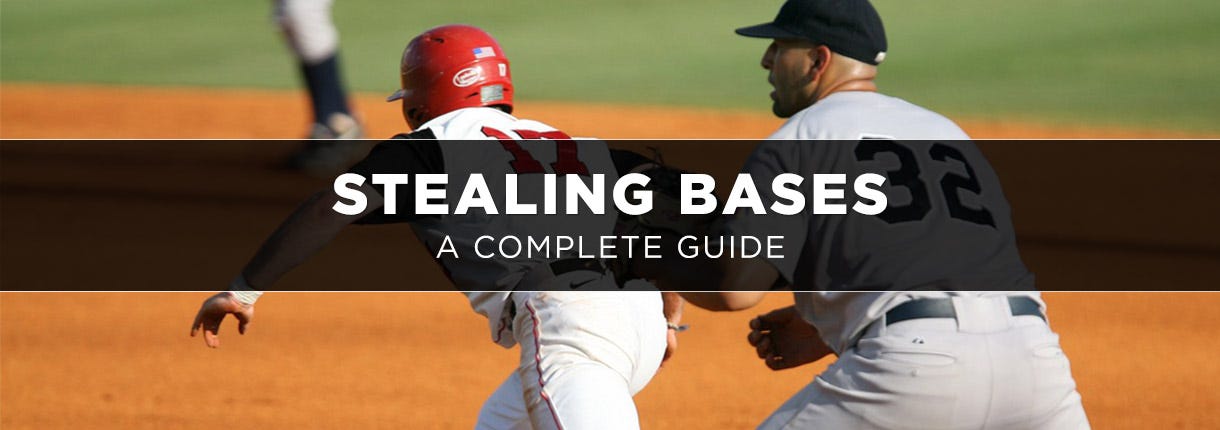Stealing Bases: Rules, Strategies and How to Steal a Base

Base stealing is a technique that, when perfectly executed, is extremely effective for the team and very exciting for the fans. Finesse and accuracy are key and not all players are capable of it.
Stealing bases is generally a planned strategy, with a few exceptions, of course. Once a runner has committed to the strategy, timing is of the essence. Run too soon and the pitcher may throw to the base rather than pitch to the batter. Run too late and odds are that the catcher will get the ball to the baseman for the out. The best base stealers are always equipped with a pair of cleats for added traction on the base paths. Luckily, we have a huge selection of baseball cleats and softball cleats to choose from!
- Rules for Stealing Bases
- When Can You Steal a Base?
- What is a Balk?
- Tips on Stealing Bases
- Does Stealing Bases Make Sense?
Rules for Stealing Bases
While there are technically a few rules or scenarios that do not allow for a base to be stolen, you are basically able to attempt a stolen base at really any time (though not always advised in certain situations). These rules include:
- You cannot steal a base on a “dead” or foul ball
- Overthrown or passed balls may be stolen on, as long as the ball is still considered to be “live”
- The base ahead of you must be unoccupied (unless the runner ahead of you also attempts to steal the base in front of them; this is known as a double steal)
When Can You Steal a Base?
Most often, we see a player steal second base since it is farthest from home plate and requires a longer throw from the catcher. Stealing third is a little more difficult since the distance from the catcher is less. Batters are often used in this situation as somewhat of an obstacle between the catcher and third baseman. Stealing home is quite possibly the most exciting base to steal, but this move requires aggressiveness and dedication. Once you're committed, follow through is mandatory. Stealing home is risky in most situations since the ball is likely to reach home plate before the runner does.
Pitchers sometimes take quite a long time in their delivery and can be slower than other pitchers to the plate. If you notice a pitcher is slow to the plate, he/she may be easier to steal a base on. Another, more tricky, potential stealing situation would be stealing on an off-speed pitch. Studying when a pitcher likes to throw their off-speed pitches in a count can give you a good idea when he/she may be throwing one. Since these pitches get to the plate slower than a fastball and are more commonly thrown in the dirt than a fastball, they will give you more time to get to the base you are attempting to steal.
What is a Balk?
Like base runners contemplating a steal, pitchers ready for the pick off also give away clues that could be very useful if you can detect them. Be sure to start studying the opposing pitcher from the time he takes the mound. Pitchers often have two distinct motions; one for pitches and one for throws to the basemen to hold a runner in place. Watch their eyes. Many pitchers look to first base before every pitch. If the pitcher fails to look in your direction, he is likely to attempt a pick off.
There are quite a few different actions or motions a pitcher can make on the mound that could be considered a balk. These can include something as simple as the pitcher dropping the ball once they have already come set on the rubber. Some more complicated balk calls can include any type of flinch or action made that is not towards home plate once the pitcher has come set. If a pitcher steps off the rubber to check the runner or for whatever reason, they must break their hands before taking the rubber again.
While a balk can be called on a handful of different situations, the most important thing to remember is that all runners on base advance one base in the instance of a balk being called. This can be used to baserunners advantage. Baserunners can make little sudden movements (faking like they are going to steal, lengthening and shortening their lead, etc.) to get the pitcher off balance or make them do something on the rubber that would be called a balk.
8 Tips for Effective Base Stealing
1. Check for signs
Keep an eye on the third base coach for signals that it's time to steal. Continue to watch for signs between pitches.
2. Lead Off
The length of your lead should be long enough to take off if given the signal to steal, yet short enough to get back to your base if necessary.
3. Check Your Stance
You want to be able to move in either direction. Keep feet slightly wider than shoulder width apart. Flex your knees and keep your weight on the balls of your feet. This will keep you ready for whatever action may arise. Do not rest your hands on your knees. Rather, keep your arms loose in front of your body.
4. Timing, Timing, Timing
Keep in mind that more successful stolen bases are done so off the pitcher than the catcher. Waiting until a pitch reaches home plate is almost a sure-fire way to get thrown out. Get a good jump as the pitcher delivers the ball and there is little even the fastest catcher can do.
Some key things to consider when getting your timing to steal a base are as follows. Try to keep track of the catchers average pop time: an average throw from a catcher to a base takes about 2 seconds. Try to read pitches and figure out when in the count the pitcher throws certain pitches: off-speed (like change ups and curves) take longer to get to the catcher and give you more time to run. Also, knowing how long it takes you to sprint between bases (90 feet) can be helpful in determining how much time you will need to steal the base.
5. Study the Pitcher
Watch the pitcher throw to the plate; note what body parts he moves first. Note anything different in his movements when he throws to first base. These variations are not on accident and should be a warning that the ball is coming your way.
- Right-handed pitchers: Watch the pitcher's stance as well. For right-handed pitchers, key in on the right foot, which will likely move off the rubber if he/she is attempting a pick-off. That's your cue to get back to your base quickly since his right foot must be touching the rubber for a pitch.
- Lefty Pitchers: Watch the pitcher's lead leg. If it swings behind the rubber, the pitcher is likely to throw home. If the pitcher's back leg bends, this will limit his/her usefulness in throwing to first base, so a pitch is more likely. Tilting back his upper body signals that you should be ready for a pick off. Pitches are usually preceded with a turning of the shoulder. When he bends his rear leg, he is most likely preparing to push off toward home.
6. Acceleration
For the first four or five steps, keep your head and body low to maintain the proper lean needed for good acceleration. Gradually straighten out as you build speed.
7. Focus on the Base
Avoid getting distracted with the location of the ball; that will just slow you down.
8. Slide!
A properly executed slide will help your body travel faster and is harder for the baseman to reach. Be sure to slide in a straight line. Hook slides are not as effective or as fast as the straight slide.
Does Stealing Bases Even Make Sense Anymore?
In an era of baseball that is run by mainly home runs and strikeouts, some people in the baseball world see stolen bases as pointless or counterintuitive. This thought process is mainly caused by all of the analytics used nowadays showing the number of stolen bases decreasing over the years. However, this does not mean that stolen bases are pointless at all. Small ball (bunting, moving runners over, stealing bases) is still a very important part of the game, in our opinion. It gives teams that do it well an advantage over teams that do not. Having a fast runner on base that has a high potential to steal not only gets in the pitcher’s head but opens the door for many more scoring opportunities; if executed correctly.
Steal Great Savings with BaseballMonkey!
There are many things to practice and perfect when it comes to stealing bases in a baseball or softball game. So now that you have read through these tips and tricks, get out there and start stealing some bases! If you need some equipment to help you practice, take a look at our selection of bases and mounds on our website!








